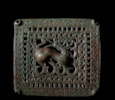Openwork Stag Plaque
An extremely large bronze plaque, possibly from a belt clasp, featuring a central motif of a stylised stag turning its head away from a small dog or fox standing on its front leg. The stag’s neck and back are curved into an S-shape, with the neck bending backwards over the slender waist. Each of the stag’s legs is represented as an abstracted curve, as is the tail. High relief teardrops add a fur-like texture to the stag’s neck. The central scene is surrounded by a border of openwork spirals, followed by a row of pillars, and a final solid border of tightly wounded spirals. The four corners are indented, possibly to hold feet, which have been lost over time. This plaque is exceptional for its large size; other extant Caucasian buckles range between circa 4 cm to 14 cm in width, and circa 2 cm to 10 cm in height.
Bronzes such as this were produced in the Caucasus region, beginning in the late second millennium B.C.. Highly stylised animals with small waists and arched necks and backs were the core motif of this style, and feature on a range of objects, including buckles, axes and pins. Examples have been found in Georgia, Armenia, Azerbaijan, and the Northern Caucasus, dating from the beginning of the Late Bronze and Early Iron ages. Cast bronze belt clasps have been excavated in the Republic of Georgia, and are one of the region’s distinct cultural outputs in the first few centuries A.D.. The openwork patterns may imitate thin plaques of gold and silver, which were decorated with twisted wire and filigree, and would have been nailed at the corners to wood and leather backings.
La Découverte de l'Asie. Hommage à René Grousset, Musée Cernuschi, Paris, 15th May – 31st July 1954.
La Découverte de l'Asie. Hommage à René Grousset, Musée Cernuschi, Paris, 15th May – 31st July 1954, no. 243, p. 60, pl. VIII.
Georges A. Salles and Daisy Lion-Goldschmidt, Collection Adolphe Stoclet: choix d'oeuvres appartenant a Madame Feron-Stoclet (premiere partie) (Brussels, 1956), pp. 302-303.
Previously in the Private Collection of Adolphe Stoclet (1871-1949), Brussels, Belgium.
Thence by descent to his daughter, Madame Raymonde Feron-Stoclet (1897-1963), Brussels, Belgium.
Thence by descent.
ALR: S00233606, with IADAA Certificate, this item has been checked against the Interpol database.
Adolphe Stoclet (1871-1949) was born to a family of Belgian bankers in Saint-Gilles, Belgium, on 30th September 1871. He studied civil engineering at the Free University of Brussels, and worked for Italian and Austrian railway companies from 1894 onwards. After his return to Brussels in 1904, he took a job with the Compagnie Internationale de Chemins de Fer, and was promoted to chairman in 1927. Stoclet became one of the directors of the Société Générale de Belgique, one of the largest holding companies in Belgium at the time. Described by contemporaries as charming but slightly pompous, Stoclet’s large beard was seen as one of his defining features – it was compared to that of the Assyrian king Ashurbanipal.
Stoclet’s wife, Suzanne, was the daughter of the art critic, historian, collector, and dealer Arthur Stevens (1825-1909) and the niece of painter Alfred Stevens (1823-1906). Through these relations, the Stoclets formed connections with avant-garde art circles in Paris. The couple entertained European royalty, as well as historians, archaeologists, writers, and musicians.
The Stoclets met architect Josef Hoffman (1870-1956), leading figure of the Vienna Succession Movement and one of the founders of the Wiener Werkstätte, while in Vienna overseeing the construction of a railroad. The couple had been on a stroll through the city, viewing the architecture, when they happened upon a villa on the Hohe Warte, where Hoffman had built a colony of modernist houses for artists and the supporters of the Vienna Succession Movement. They shortly commissioned him to design a grand mansion in Brussels in 1905. Despite complications in the design and huge funding requirements, they persisted with building what is now considered one of the great examples of Vienna Secession architecture. Hoffman tasked the best designers working at the Wiener Werkstätte with the project, including Koloman Moser, Carl Otto Czeschka, Ludwig Heinrich Jungnickel, and Emilie Schleiss-Simandl. Notable artists like Gustav Klimt, Richard Luksh, Georges Minne, Franz Metzner, and Fernard Khnopff were charged with interior decoration.
The collection stored in the palace was eclectic and encyclopaedic, featuring art from ancient China, Cambodia, Egypt, Mesopotamia, pre-Columbian Mexico, and tribal Africa, alongside late medieval Italian painting, metalwork, enamels, and relics. The Stoclets resided in the palace until 1949, when Adolphe died on 3rd November, and Suzanne followed a fortnight later. Their art collection was divided between their three children, René (b. 1902), Jacques (b. 1903), and Raymonde (1897-1963). Stoclet Palace, now listed as a UNESCO World Heritage site and a Belgian landmark since 1976, is still occupied by their heirs today.










 Enquire
Enquire




